As Compared to Children in Two Parent Families
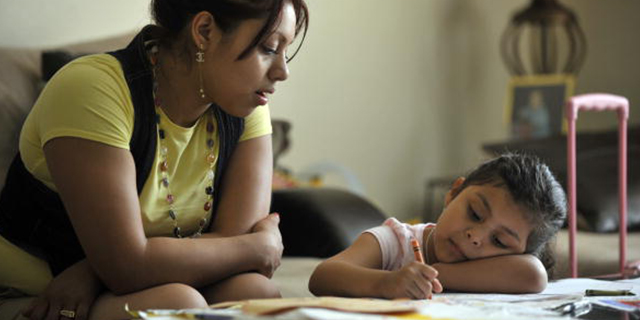
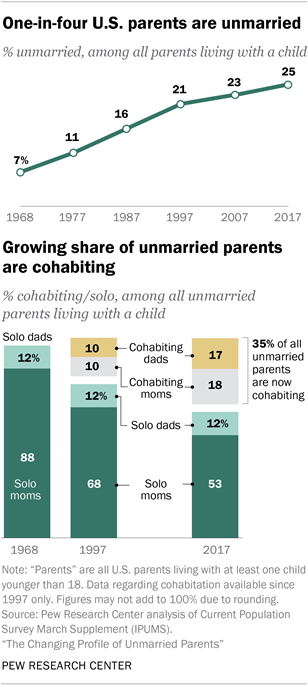 One-in-4 parents living with a child in the Usa today are unmarried. Driven by declines in union overall, as well as increases in births outside of union, this marks a dramatic modify from a one-half-century agone, when fewer than one-in-ten parents living with their children were single (7%).
One-in-4 parents living with a child in the Usa today are unmarried. Driven by declines in union overall, as well as increases in births outside of union, this marks a dramatic modify from a one-half-century agone, when fewer than one-in-ten parents living with their children were single (7%).
At the same time, the profile of unmarried parents has shifted markedly, according to a new Pew Research Centre analysis of Census Agency data.1 Solo mothers – those who are raising at to the lowest degree 1 kid with no spouse or partner in the home – no longer dominate the ranks of single parents as they once did. In 1968, 88% of unmarried parents fell into this category. Past 1997 that share had dropped to 68%, and in 2017 the share of unmarried parents who were solo mothers declined to 53%. These declines in solo mothers have been entirely offset by increases in cohabitating parents: Now 35% of all unmarried parents are living with a partner.2 Meanwhile, the share of unmarried parents who are solo fathers has held steady at 12%.
Due primarily to the rising number of cohabiting parents, the share of unmarried parents who are fathers has more than than doubled over the past 50 years. Now, 29% of all unmarried parents who reside with their children are fathers, compared with just 12% in 1968.
While information technology'due south well-established that married parents are typically better off financially than unmarried parents, in that location are besides differences in fiscal well-existence among unmarried parents. For instance, a much larger share of solo parents are living in poverty compared with cohabiting parents (27% vs. 16%).three There are differences in the demographic profiles of each group equally well. Cohabiting parents are younger, less educated and less likely to take e'er been married than solo parents. At the same fourth dimension, solo parents accept fewer children on average than cohabiting parents and are far more probable to exist living with one of their own parents (23% vs. 4%).
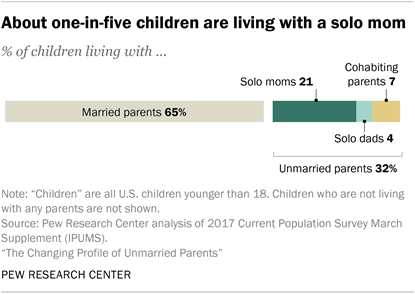 Equally the number of parents who are unmarried has grown, and so has the number of children living with an unmarried parent. In 1968, 13% of children – 9 million in all – were living in this type of arrangement, and by 2017, that share had increased to almost one-third (32%) of U.Southward. children, or 24 1000000. All the same, the share of children who will ever feel life with an unmarried parent is likely considerably higher, given how fluid U.S. families accept become. I estimate suggests that by the time they turn nine, more than twenty% of U.S. children built-in to a married couple and over fifty% of those born to a cohabiting couple will have experienced the breakup of their parents, for instance. The failing stability of families is linked both to increases in cohabiting relationships, which tend to be less long-lasting than marriages, likewise as long-term increases in divorce. Indeed, half of solo parents in 2017 (52%) had been married at one fourth dimension, and the aforementioned is true for about one-third of cohabiting parents (35%).
Equally the number of parents who are unmarried has grown, and so has the number of children living with an unmarried parent. In 1968, 13% of children – 9 million in all – were living in this type of arrangement, and by 2017, that share had increased to almost one-third (32%) of U.Southward. children, or 24 1000000. All the same, the share of children who will ever feel life with an unmarried parent is likely considerably higher, given how fluid U.S. families accept become. I estimate suggests that by the time they turn nine, more than twenty% of U.S. children built-in to a married couple and over fifty% of those born to a cohabiting couple will have experienced the breakup of their parents, for instance. The failing stability of families is linked both to increases in cohabiting relationships, which tend to be less long-lasting than marriages, likewise as long-term increases in divorce. Indeed, half of solo parents in 2017 (52%) had been married at one fourth dimension, and the aforementioned is true for about one-third of cohabiting parents (35%).
While information technology has become more common in contempo decades, many Americans view the increase in unmarried parenthood – solo mothering especially – as a negative tendency for society. In a 2015 Pew Inquiry Eye survey, two-thirds of adults said that more single women raising children on their ain was bad for society, and 48% said the same about more single couples raising children. Credence of single parenthood tends to be particularly low among whites, college graduates, and Republicans. Nonetheless, other data suggest a slight uptick in acceptance. In 1994, 35% of adults agreed or strongly agreed that single parents could raise children too equally two married parents, co-ordinate to data from the General Social Survey; by 2012 the share who said as much had risen to 48%.
Declines in marriage and increases in nonmarital births have driven ascension in single parenting
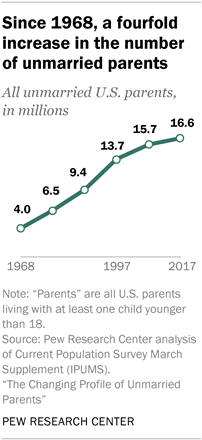 The rising over the past half-century in the share of all U.S. parents who are unmarried and living with a child younger than 18 has been driven by increases in all types of unmarried parents. In 1968, only 1% of all parents were solo fathers; that figure has risen to 3%. At the same time, the share of all parents who are solo mothers has doubled, from 7% up to thirteen%. Since 1997, the outset twelvemonth for which data on cohabitation are available, the share of parents that are cohabiting has risen from 4% to 9%.
The rising over the past half-century in the share of all U.S. parents who are unmarried and living with a child younger than 18 has been driven by increases in all types of unmarried parents. In 1968, only 1% of all parents were solo fathers; that figure has risen to 3%. At the same time, the share of all parents who are solo mothers has doubled, from 7% up to thirteen%. Since 1997, the outset twelvemonth for which data on cohabitation are available, the share of parents that are cohabiting has risen from 4% to 9%.
All told, more than xvi million U.S. parents with no spouse at habitation are at present living with their child younger than xviii, up from four million in 1968 and just nether 14 million in 1997.
The growth in single parenthood overall has been driven past several demographic trends. Peradventure most important has been the decline in the share of people overall who are married. In 1970, well-nigh seven-in-10 U.S. adults ages 18 and older were married; in 2016, that share stood at 50%. Both delays in union and long-term increases in divorce have fueled this trend. In 1968, the median age at showtime marriage for men was 23 and for women it was 21. In 2017, the median age at first marriage was 30 for men and 27 for women. At the same time, marriages are more likely to stop in divorce now than they were nearly half a century ago.iv For instance, amid men whose first marriage began in the belatedly 1980s, virtually 76% were nevertheless in those marriages 10 years later, while this figure was 88% for men whose marriages began in the belatedly 1950s.
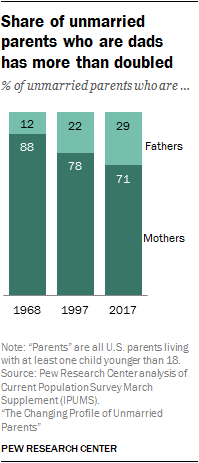 Not only are fewer Americans getting married, but information technology's besides condign more than common for unmarried people to take babies. In 1970 there were 26 births per 1,000 single women ages 15 to 44, while that charge per unit in 2016 stood at 42 births per 1,000 unmarried women. Meanwhile, birthrates for married women take declined, from 121 births per 1,000 down to about 90. As a result, in 2016 4-in-ten births were to women who were either solo mothers or living with a nonmarital partner.
Not only are fewer Americans getting married, but information technology's besides condign more than common for unmarried people to take babies. In 1970 there were 26 births per 1,000 single women ages 15 to 44, while that charge per unit in 2016 stood at 42 births per 1,000 unmarried women. Meanwhile, birthrates for married women take declined, from 121 births per 1,000 down to about 90. As a result, in 2016 4-in-ten births were to women who were either solo mothers or living with a nonmarital partner.
Increases in the number of cohabiting parents raising children have also contributed to the overall growth in single parenthood. In 1997, the offset yr for which data on cohabitation are available, twenty% of single parents who lived with their children were also living with a partner.5 Since that time, the share has risen to 35%.
This trend has boosted the overall share of single parents who are fathers. In 1968, just 12% were fathers; by 1997 the share had risen to 22%, and in 2017 it stood at 29%. At the same time, solo parents remain overwhelmingly female: 81% of solo parents in 2017 were mothers, as were 88% in 1968.
For solo and cohabiting parents, very different demographic profiles
As a result of the ascension and transformation of unmarried parenthood in the U.S., significant demographic differences now exist not only between married and unmarried parents, but amidst unmarried parents. And in some cases, even among solo or cohabiting parents, dramatic differences take emerged between fathers and mothers.
Compared with cohabiting parents, solo parents are more probable to be female and black
Because cohabiting parents are overwhelmingly opposite-sex couples, they are most evenly split between men and women.half dozen Among solo parents, however, the vast bulk (81%) are mothers; simply 19% are fathers. This gender difference is fifty-fifty more pronounced among blackness solo parents: 89% are mothers and just eleven% are fathers.
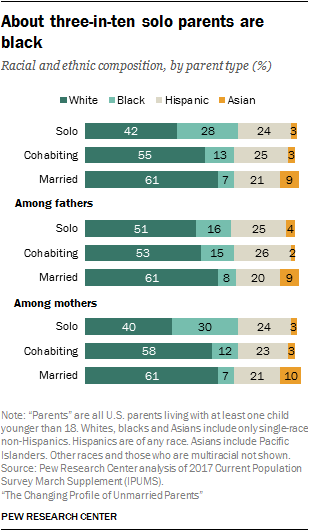 Overall, at that place are significant differences in the racial and ethnic profiles of solo and cohabiting parents. Among solo parents, 42% are white and 28% are black, compared with 55% of cohabiting parents who are white and 13% who are blackness.
Overall, at that place are significant differences in the racial and ethnic profiles of solo and cohabiting parents. Among solo parents, 42% are white and 28% are black, compared with 55% of cohabiting parents who are white and 13% who are blackness.
These gaps are driven largely by racial differences amongst the big share of solo parents who are mothers. Solo moms are more than twice as likely to be black every bit cohabiting moms (30% vs. 12%), and roughly four times as likely as married moms (7% of whom are black). Four-in-ten solo mothers are white, compared with 58% of cohabiting moms and 61% of married moms.
In that location are virtually no racial and ethnic differences in the profiles of solo and cohabiting fathers. About half of each group are white, roughly 15% are black, about one-fourth are Hispanic and a small share are Asian. Married fathers, nonetheless, are more than probable than single fathers to exist white (61% are) and less probable to be blackness (8%).
Only 3% of solo or cohabiting parents are Asian, compared with 9% of married parents. A similar design emerges amongst both Asian fathers and mothers.
Amidst all parents, Hispanics are almost every bit represented across all iii family types – solo, cohabiting and married parents – with no large differences among Hispanic mothers and Hispanic fathers.
Solo parents are older, more educated and more likely to have been married than cohabiting parents
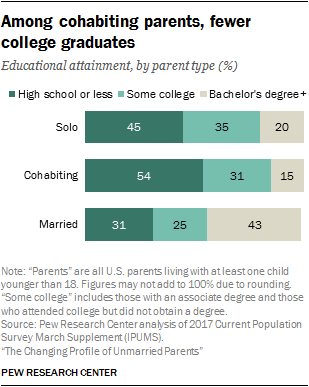 Cohabiting parents are younger on average than solo or married parents. Their median age is 34 years, compared with 38 among solo parents and xl among married parents.
Cohabiting parents are younger on average than solo or married parents. Their median age is 34 years, compared with 38 among solo parents and xl among married parents.
Cohabiting parents have lower levels of educational attainment than other parents, due at least in part to their relative youth. Just over half (54%) of cohabiting parents have a high schoolhouse diploma or less teaching, compared with 45% of solo parents and 31% of married parents. At the other terminate of the spectrum, fifteen% of cohabiting parents take at least a bachelor'southward degree, compared with 20% of solo parents. Married parents, in contrast, are more than twice as likely as single parents to take a available's caste (43% do), reflecting the growing gap in marriage across educational levels.
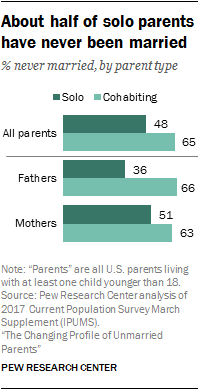 Cohabiting fathers, in item, have lower levels of didactics than their solo counterparts. Roughly half-dozen-in-ten cohabiting fathers (61%) – versus 51% of solo fathers – have a high school diploma or less education. Conversely, only 12% of cohabiting fathers take a available's caste, while 21% of solo fathers do. There are no large educational differences in the profile of solo and cohabiting mothers.
Cohabiting fathers, in item, have lower levels of didactics than their solo counterparts. Roughly half-dozen-in-ten cohabiting fathers (61%) – versus 51% of solo fathers – have a high school diploma or less education. Conversely, only 12% of cohabiting fathers take a available's caste, while 21% of solo fathers do. There are no large educational differences in the profile of solo and cohabiting mothers.
The relative youthfulness of cohabiting parents also contributes to the high share (65%) that have never married, meaning that most children with cohabiting parents were born outside of marriage. In contrast, about half (48%) of solo parents have never been married.
Cohabiting mothers and fathers are about every bit likely to accept never married. Among solo parents, however, mothers are more likely than fathers to have never been married (51% of solo mothers vs. 36% of solo fathers), suggesting that solo mothers and solo fathers may take somewhat different paths to unmarried parenthood.
Three-in-ten solo mothers are living in poverty
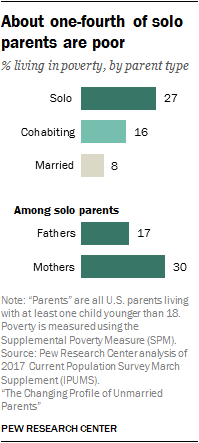 Despite the fact that cohabiting parents are younger and less educated than solo parents, they are even so far less likely to be poor. All told, sixteen% of unmarried parents living with a partner are living beneath the poverty line, while almost one-fourth (27%) of solo parents are. In comparison, just viii% of married parents are living in poverty.7
Despite the fact that cohabiting parents are younger and less educated than solo parents, they are even so far less likely to be poor. All told, sixteen% of unmarried parents living with a partner are living beneath the poverty line, while almost one-fourth (27%) of solo parents are. In comparison, just viii% of married parents are living in poverty.7
Among solo parents, mothers are virtually twice as likely as fathers to exist living beneath the poverty line (30% vs. 17%), but poverty rates for cohabiting parents don't differ among mothers and fathers.
Solo and cohabiting parents are about equally likely to be employed (72% and 73%, respectively). However, a majority (53%) of cohabiting parents are in a dual-earner household, which accounts for some of the differences in poverty levels betwixt the two groups.
Roughly one-in-four solo parents are living with their own parent
Not only do solo and cohabiting parents differ in terms of their demographic and economical profiles, merely their household situations are dissimilar as well. Solo parents don't accept a partner at abode, just they are far more likely than their married and cohabiting counterparts to be living with at least one of their own parents – 23% do. This is particularly common among solo dads, 31% of whom are residing with at least i of their parents. Among solo moms, this effigy stands at 22%. In comparison, only 4% of cohabiting parents are living with at least one of their ain or their partner'due south parents – the aforementioned share as among their married counterparts.
 While the office of these grandparents cannot be determined for certain from this data, prior Pew Enquiry Center analyses of 2011 Census Agency information suggest that many could be playing an important role as caregiver to whatever grandchildren in the household. In fact, a 2013 analysis establish that amongst all grandparents who lived with at to the lowest degree i grandchild at the fourth dimension (whether the kid's parent was present or not), about four-in-x (39%) said they were responsible for almost of that grandchild's bones needs.
While the office of these grandparents cannot be determined for certain from this data, prior Pew Enquiry Center analyses of 2011 Census Agency information suggest that many could be playing an important role as caregiver to whatever grandchildren in the household. In fact, a 2013 analysis establish that amongst all grandparents who lived with at to the lowest degree i grandchild at the fourth dimension (whether the kid's parent was present or not), about four-in-x (39%) said they were responsible for almost of that grandchild's bones needs.
Cohabiting parents have more children, on boilerplate, than solo parents do. Just over one-half (53%) of cohabiting parents have more than 1 child at domicile, compared with 44% of solo parents. Amidst solo parents, though, moms are more likely than dads to have multiple kids at home – virtually one-half (46%) practise, while 35% of solo fathers are raising more one child.
Cohabiting parents are also more likely than their solo counterparts to have young children at home. This is linked to the fact that they themselves tend to be younger. Fully 60% of cohabiting parents are living with at to the lowest degree one child younger than half-dozen, compared with 37% of solo parents and 44% of married parents. Amid solo parents, mothers are much more likely than fathers to accept a preschool-age child in the house. About iv-in-10 (39%) exercise, compared with 26% of dads.
Public views of unmarried parenthood
As unmarried parenthood has grown more common in the U.Southward., the public has become somewhat more accepting of information technology, though large shares say that this trend is bad for society.
A 2015 Pew Research Center survey found that the trends toward more single women having children and more single couples raising children were seen as relatively more harmful to society, compared with other changes in American families.eight
Americans were far more likely to limited a negative view regarding the rise of single mothers than whatsoever other trend: Two-thirds (66%) said that more single women having children was bad for society, and only 4% said this trend was expert for society (the remaining 29% said the trend doesn't make much difference). At the same time, about half (48%) said more unmarried couples raising children was bad for society, while but half dozen% said information technology was good for society and 45% said it didn't brand much difference.
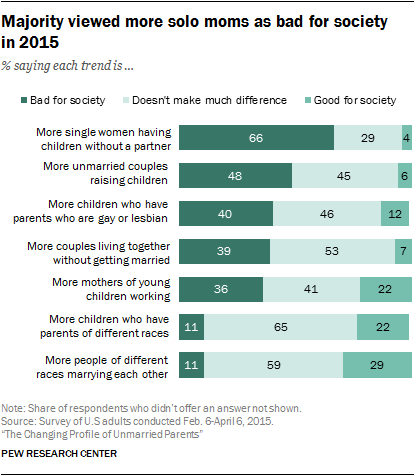 By comparison, other family trends were seen equally less negative, though substantial shares saw some of those trends as bad for society. For example, four-in-ten adults said that the growing number of children who have parents who are gay or lesbian was bad for society, and a similar share (39%) said the same about more than couples living together without existence married. When it came to more mothers of young children working outside the abode, 36% said this was a bad matter, just a sizable minority (22%) saw it as a good thing. Relatively few Americans (xi%) said the trends toward more children with parents of unlike races and more interracial marriages were bad for lodge; at to the lowest degree twice every bit many viewed each of these trends as good for society (22% and 29%, respectively). In each example, majorities or pluralities of the public said these trends didn't make much of a difference for society.
By comparison, other family trends were seen equally less negative, though substantial shares saw some of those trends as bad for society. For example, four-in-ten adults said that the growing number of children who have parents who are gay or lesbian was bad for society, and a similar share (39%) said the same about more than couples living together without existence married. When it came to more mothers of young children working outside the abode, 36% said this was a bad matter, just a sizable minority (22%) saw it as a good thing. Relatively few Americans (xi%) said the trends toward more children with parents of unlike races and more interracial marriages were bad for lodge; at to the lowest degree twice every bit many viewed each of these trends as good for society (22% and 29%, respectively). In each example, majorities or pluralities of the public said these trends didn't make much of a difference for society.
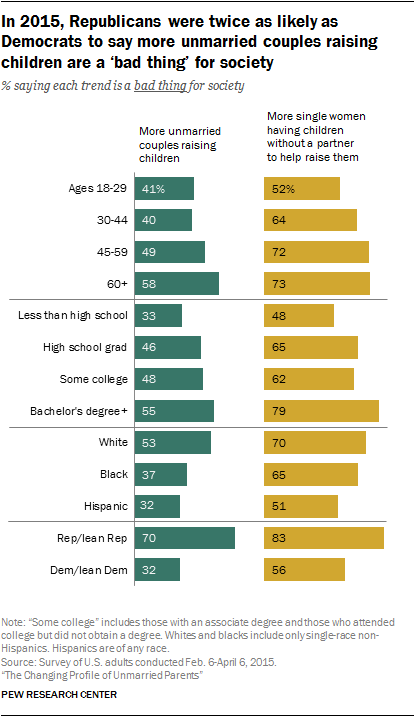 Views on unmarried parents vary widely by political party affiliation. The overwhelming majority (83%) of Republicans and independents who lean to the Republican Party said that more single women having children without a partner is bad for society; 56% of Democrats and those who lean Democratic said the same. Partisan differences were even wider on attitudes about unmarried parents raising children together: While 70% of Republicans saw this every bit bad for club, near half every bit many Democrats (32%) said the same.
Views on unmarried parents vary widely by political party affiliation. The overwhelming majority (83%) of Republicans and independents who lean to the Republican Party said that more single women having children without a partner is bad for society; 56% of Democrats and those who lean Democratic said the same. Partisan differences were even wider on attitudes about unmarried parents raising children together: While 70% of Republicans saw this every bit bad for club, near half every bit many Democrats (32%) said the same.
Older Americans and those with higher levels of education were especially likely to view these trends equally bad for lodge.
In that location were racial and indigenous gaps as well, particularly on views most unmarried couples raising children: 53% of whites viewed more unmarried couples raising children every bit a bad thing, compared with 37% of blacks and 32% of Hispanics.
Other information suggest there has been some softening in views towards unmarried parenthood. In 2012, 48% of adults agreed or strongly agreed that single parents could raise children equally well equally 2 parents tin can, according to the General Social Survey. This marked a slight increase from 1994, when just 35% said as much. At the same time, the share of people who disagreed or strongly disagreed that single parents could enhance children every bit well as two parents ticked down, from 48% to 41%.
Nearly the information
This study is based primarily on data from the U.S. Census Bureau's March Supplement of the Current Population Survey (CPS), also known as the Annual Social and Economic Supplement (ASEC). The survey produces a nationally representative sample of the non-institutionalized U.S. population. The analysis in this report starts with 1968, the beginning year for which ASEC information are publicly available.
Because the CPS is based on households, only parents who are living with at least one of their children younger than 18 are included in this analysis. Prior Pew Inquiry Centre analysis indicates that 17% of fathers of children younger than 18 are living apart from all of these children, and fathers living apart from their children take unlike characteristics than those who alive with their children.
The CPS does not explicitly ask most custody arrangements, but any parent whose child lives with them most of the time is counted every bit "living with" that child. In cases where custody is split 50-l, the parent is counted every bit "living with" their child if the child is present at the time of the interview.
Throughout this report, "fathers," "mothers" and "parents" refer to people who are living with their child younger than xviii years, and to people who are their spouses or partners. These include both biological parents and parents who are non biologically linked to the children in their family.
The Current Population Survey (CPS) does not explicitly inquire most custody arrangements, but any parent whose child lives with them most of the time is counted as "living with" that child. In cases where custody is dissever fifty-50, the parent is counted equally "living with" their child if the kid is present at the time of the interview.
All cohabiting parents – meaning parents who are living with a partner to whom they are not married – are identified in analyses since 2007. From 1995 to 2006, the CPS only collected data on cohabitation among unmarried household heads, so only those respondents and their partners are counted as cohabiting. This leads to an undercount of cohabiting parents for those years. The size of this undercount prior to 2007 tin't be determined, but in 2007 the vast majority (93%) of all cohabiting parents were either the head of household or the partner of the caput. Prior to 1995, cohabiting couples were not identified in the CPS.
All aforementioned-sex couples, regardless of their marital status, are classified as "cohabiting," since that is the convention used in the CPS. For more on same-sex parents, see "LGB Families and Relationships: Analyses of the 2013 National Health Interview Survey."
The small share of parents who are married but not living with a spouse or partner are classified equally "solo parents," forth with those who are neither married nor living with a partner.
"Some higher" includes those with an associate degree and those who attended college but did not obtain a degree. "High school" includes those who accept a high schoolhouse diploma or its equivalent, such as a General Education Evolution (GED) certificate.
Whites, blacks and Asians include only unmarried-race non-Hispanics. Hispanics are of whatsoever race. Asians include Pacific Islanders.
Source: https://www.pewresearch.org/social-trends/2018/04/25/the-changing-profile-of-unmarried-parents/